The Department of Agriculture is drawing up plans to significantly increase local dairy milk production, including seeking support from local milk processors to bolster investment in the industry and increase dairy cattle population.
In a meeting with the Philippine Chamber of Agriculture and Food, Inc. (PCAFI), Agriculture Secretary Francisco Tiu Laurel Jr. said the DA will review Republic Act 7884, or The National Dairy Development Act of 1995, particularly its provision requiring commercial milk processors and domestic dairy cooperatives to agree on the volume of locally produced milk that will be absorbed by the commercial sector.
A volume would have been determined three years after the passage of the act, or by 1998. Despite the passage of the law, however, domestic production remains low at less than 1 percent of annual demand.
“The development of the dairy industry is a low-hanging fruit.”
“We will draft a measure that will activate the provision of the dairy law,” Tiu Laurel said, who had earlier described the development of the dairy industry as “a low-hanging fruit” in the country’s drive to boost economic growth and increase income of those who depend on the industry.
“The DA should set a rule that will require commercial milk processors and traders to secure their milk supply from local sources (at a volume of) at least five percent of their total requirement, within a full or staggered basis over a certain fixed period.”
PCAFI said a volume hasn’t be agreed upon and suggested the DA, through the National Dairy Authority, set a rule that will “require commercial milk processors and traders to secure their milk supply from local sources (at a volume of) at least five percent of their total requirement, within a full or staggered basis over a certain fixed period.”
Despite two laws—RA 7884 and Batas Pambansa 21 or the Dairy Industry Development Act passed in 1980, investments in Philippine dairy milk production remain low despite steady growth in dairy demand.
The country imported $1.6 billion of milk in 2022, mostly in powdered form, from Australia, New Zealand and the U.S.
PCAFI said if commercial processors and traders won’t agree to a minimum volume, then the DA could either require a safeguard duty on imported milk that will help fund the development of the local dairy industry or require commercial processors and traders to establish their own dairy farms in the Philippines.
NDA records show that cattle production in 2023 reached 17,850 metric tons, accounting for roughly 0.8 percent of total milk consumption of 1.937 million metric tons.
Output in 2022 stood at 16,678 metric tons. NDA projects consumption this year to reach 1.978 million metric tons.



